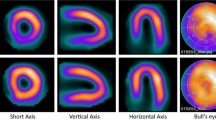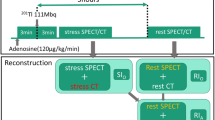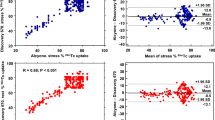Abstract
Background
Data regarding cardiac cadmium-zinc-telluride (CZT)-specific augmented databases and their impact on CT-based attenuation correction (AC) perfusion scores in myocardial perfusion imaging (MPI) were obtained on a multiple-pinhole CZT SPECT/CT.
Methods and Results
Summed stress (SSS) and rest scores (SRS) were measured using automated software in three independent patient groups: group 1 (n = 80) underwent MPI on both CZT and conventional sodium iodide (NaI) devices, group 2 (n = 80) with low coronary artery disease likelihood and normal MPI provided reference CZT databases; and group 3 (n = 152) served to compare AC and non-AC (NAC) scores on CZT. Group 1 CZT and NaI scores gave a significant 1:1 linear correlation for CZT scores referenced to the custom database vs NaI scores referenced to the default database, but these were not concordant when CZT scores were referenced to the default database. AC significantly decreased average SSS and SRS in men vs NAC, 4.29 ± 6.30 vs 5.37 ± 7.26 (P < 0.001) and 2.37 ± 4.72 vs 3.13 ± 5.85 (P < 0.001), but not in women, 2.28 ± 3.42 vs 2.28 ± 3.08 (p NS) and 0.46 ± 1.51 vs 0.61 ± 1.86, (p NS), respectively.
Conclusions
Specifically designed databases for solid-state CZT cardiac SPECT provide accurate quantitation of perfusion scores concordant with those previously validated for conventional SPECT. AC and NAC CZT scores differed significantly, especially in men.




Similar content being viewed by others
Abbreviations
- AC:
-
Attenuation correction
- CAD:
-
Coronary artery disease
- CTAC:
-
Computed tomography-based attenuation correction
- CZT:
-
Cadmium-zinc-telluride
- MPI:
-
Myocardial perfusion imaging
- NAC:
-
No attenuation correction
- NaI:
-
Sodium iodide
- SPECT:
-
Single-photon emission computerized tomography
- SRS:
-
Summed rest score
- SSS:
-
Summed stress score
References
Hendel RC, Berman DS, Di Carli MF, Heidenreich PA, Henkin RE, Pellikka PA, et al. ACCF/ASNC/ACR/AHA/ASE/SCCT/SCMR/SNM 2009 appropriate use criteria for cardiac radionuclide imaging. J Am Coll Cardiol. 2009;53:2201-29.
Hendel RC, Abbott BG, Bateman TM, Blankstein R, Calnon DA, Leppo JA, et al. ASNC information statement: The role of radionuclide myocardial perfusion imaging for asymptomatic individuals. J Nucl Cardiol. 2011;18:3-15.
Herzog BA, Buechel RR, Katz R, Brueckner M, Husmann L, Burger IA, et al. Nuclear myocardial perfusion imaging with a cadmium-zinc-telluride detector technique: Optimized protocol for scan time reduction. J Nucl Med. 2010;51:46-51.
Iskandrian AE. Stress-only myocardial perfusion imaging: A new paradigm. J Am Coll Cardiol. 2010;55:231-3.
Dorbala S, Di Carli MF, Delbeke D, Abbara S, DePuey EG, Dilsizian V, et al. SNMMI/ASNC/SCCT guideline for cardiac SPECT/CT and PET/CT 1.0*. J Nucl Med. 2013;54:1485-507.
Organisation for Economic Co-Operation and Development, Nuclear Energy Agency. The supply of medical radioisotopes implementation of the HLG-MR policy approach: Results from a self-assessment by the global 99Mo/99mTc supply chain. The Supply of medical radioisotopes series 2013. http://www.oecdnea. org/med-radio/med-radio-series.html.
Bocher M, Blevis IM, Tsukerman L, Shrem Y, Kovalski G, Volokh L. A fast cardiac gamma camera with dynamic SPECT capabilities: Design, system validation and future potential. Eur J Nucl Med Mol Imaging. 2010;37:1887-902.
Ather S, Iqbal F, Gulotta J, Aljaroudi W, Heo J, Iskandrian AE, Hage FG. Comparison of three commercially available softwares for measuring left ventricular perfusion and function by gated SPECT myocardial perfusion imaging. J Nucl Cardiol. 2014;21:673-81.
Germano G, Kavanagh PB, Waechter P, Areeda J, Van Kriekinge S, Sharir T, et al. A new algorithm for the quantitation of myocardial perfusion SPECT. I: Technical principles and reproducibility. J Nucl Med. 2000;41:712-9.
Berman DS, Kang X, Gransar H, Gerlach J, Friedman JD, Hayes SW, et al. Quantitative assessment of myocardial perfusion abnormality on SPECT myocardial perfusion imaging is more reproducible than expert visual analysis. J Nucl Cardiol. 2009;16:45-53.
Nakazato R, Tamarappoo BK, Kang X, Wolak A, Kite F, Hayes SW, et al. Quantitative upright–supine high-speed SPECT myocardial perfusion imaging for detection of coronary artery disease: Correlation with invasive coronary angiography. J Nucl Med. 2010;51:1724-31.
Garcia EV, Folks RD, Raggi P, Keidar Z, Askew JW, Rispler S, et al. Quantitation of gated rest/stress Tc-99m tetrofosmin ultrafast CZT myocardial perfusion imaging: Development of normal limits and multicenter validation. The 15th Annual Scientific Session of the American Society of Nuclear Cardiology September 23-26, 2010. ASNC Abstracts. 2010;17:721.
Duvall WL, Slomka PJ, Gerlach JR, Sweeny JM, Baber U, Croft LB, et al. High-efficiency SPECT MPI: Comparison of automated quantification, visual interpretation, and coronary angiography. J Nucl Cardiol. 2013;20:763-73.
Sharir T, Pinskiy M, Pardes A, Rochman A, Prokhorov V, Kovalski G, et al. Comparison of the diagnostic accuracies of very low stress-dose with standard-dose myocardial perfusion imaging: Automated quantification of one-day, stress-first SPECT using a CZT camera. J Nucl Cardiol. 2016;23:11-20.
Hachamovitch R, Berman DS, Shaw LJ, Kiat H, Cohen I, Cabico JA, et al. Incremental prognostic value of myocardial perfusion single photon emission computed tomography for the prediction of cardiac death: Differential stratification for risk of cardiac death and myocardial infarction. Circulation. 1998;97:535-43.
Genovesi D, Giorgetti A, Gimelli A, Kusch A, D’Aragona Tagliavia I, Casagranda M, et al. Impact of attenuation correction and gated acquisition in SPECT myocardial perfusion imaging: Results of the multicentre SPAG (SPECT attenuation correction vs gated) study. Eur J Nucl Med Mol Imaging. 2011;38:1890-8.
Pourmoghaddas A, Vanderwerf K, Ruddy TD, Wells RG. Scatter correction improves concordance in SPECT MPI with a dedicated cardiac SPECT solid-state camera. J Nucl Cardiol. 2014;22:334-43.
Hendel RC, Berman DS, Di Carli MF, Heidenreich PA, Henkin RE, Pellikka PA. Appropriate use criteria for cardiac radionuclide imaging: A report of the American College of Cardiology Foundation Appropriate Use Criteria Task Force, the American Society of Nuclear Cardiology, the American College of Radiology, the American Heart Association, the American Society of Echocardiography, the Society of Cardiovascular Computed Tomography, the Society for Cardiovascular Magnetic Resonance, and the Society of Nuclear Medicine. J Am Coll Cardiol. 2009;53:2201-9.
Diamond GA, Forrester JS. Analysis of probability as an aid in the clinical diagnosis of coronary-artery disease. N Engl J Med. 1979;300:1350-8.
Hebert T, Leahy R. A generalized EM algorithm for 3D Bayesian reconstruction from Poisson data using Gibbs priors. IEEE Trans Med Imaging. 1989;8:194-202.
Green PJ. Bayesian reconstructions from emission tomography data using a modified EM algorithm. IEEE Trans Med Imaging. 1990;9:84-93.
Hudson HM, Larkin RS. Accelerated image reconstruction using ordered subsets of projection data. IEEE Trans Med Imaging. 1994;13:601-9.
Kennedy JA, Israel O, Frenkel A. Directions and magnitudes of misregistration of CT attenuation-corrected myocardial perfusion studies: Incidence, impact on image quality, and guidance for reregistration. J Nucl Med. 2009;50:1471-8.
Hindorf C, Oddstig J, Hedeer F, Hansson MJ, Jögi J, Engblom H. Importance of correct patient positioning in myocardial perfusion SPECT when using a CZT camera. J Nucl Cardiol. 2014;21:695-702.
Liu CJ, Cheng JS, Chen YC, Huang YH, Yen RF. A performance comparison of novel cadmium–zinc–telluride camera and conventional SPECT/CT using anthropomorphic torso phantom and water bags to simulate soft tissue and breast attenuation. Ann Nucl Med. 2015;29:342-50.
Kennedy JA, Israel O, Frenkel A. 3D iteratively reconstructed spatial resolution map and sensitivity characterization of a dedicated cardiac SPECT camera. J Nucl Cardiol. 2014;21:443-52.
Fiechter M, Gebhard C, Fuchs TA, Ghadri JR, Stehli J, Kazakauskaite E, et al. Cadmium-zinc-telluride myocardial perfusion imaging in obese patients. J Nucl Med. 2012;53:1401-6.
Gimelli A, Bottai M, Genovesi D, Giorgetti A, Di Martino F, Marzullo P. High diagnostic accuracy of low-dose gated-SPECT with solid-state ultrafast detectors: Preliminary clinical results. Eur J Nucl Med Mol Imaging. 2012;39:83-90.
DePuey EG. How to detect and avoid myocardial perfusion SPECT artifacts. J Nucl Med. 1994;35:699-702.
Jameria ZA, Abdallah M, Fernandez-Ulloa M, O’Donnell R, Dwivedi AK, Washburn E, et al. Analysis of stress-only imaging, comparing upright and supine CZT camera acquisition to conventional gamma camera images with and without attenuation correction, with coronary angiography as a reference. J Nucl Cardiol. 2017. doi:10.1007/s12350-017-0781-7.
Disclosures
Ora Israel is a consultant to GE Healthcare. No other author has any financial disclosures in relationship to this study.
Author information
Authors and Affiliations
Corresponding author
Additional information
The authors of this article have provided a PowerPoint file, available for download at SpringerLink, which summarises the contents of the paper and is free for re-use at meetings and presentations. Search for the article DOI on SpringerLink.com.
Electronic supplementary material
Below is the link to the electronic supplementary material.
Rights and permissions
About this article
Cite this article
Kennedy, J.A., Brodov, Y., Weinstein, A.L. et al. The effect of CT-based attenuation correction on the automatic perfusion score of myocardial perfusion imaging using a dedicated cardiac solid-state CZT SPECT/CT. J. Nucl. Cardiol. 26, 236–245 (2019). https://doi.org/10.1007/s12350-017-0905-0
Received:
Accepted:
Published:
Issue Date:
DOI: https://doi.org/10.1007/s12350-017-0905-0




